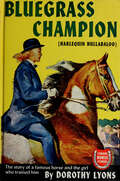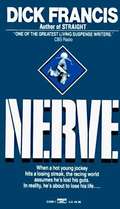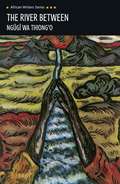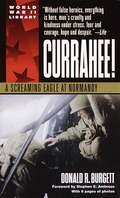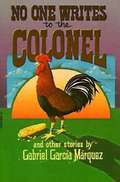- Table View
- List View
Men Against Fire: The Problem of Battle Command in Future War
by S. L. A. MarshallThis book examines why only one in four men in battle seem to fire their guns, and offers means by which the number of active soldiers can be increased.
What About Me?
by Colby RodowskyDorrie adores art. She is determined that she will graduate from high school in New York, and go on to art school. When her parents tell her that they will be leaving the city so that Dorrie's mother will have more help caring for Dorrie's younger brother who is developmentally delayed, Dorrie is furious. She is often resentful of the time and attention her parents devote to her brother, embarrassed by his odd behaviour, and angry that she is asked to make social sacrifices in order to help care for him, and this decision to move only fuels her anger and resentment. In the end, something happens that makes Dorrie reassess her feelings.
Beany Malone (Beany Malone Series, #2)
by Lenora Mattingly WeberWhen Beany Malone stops long enough to evaluate her relative status at Harkness High, where she is a sophomore, she has to conclude she is a "mop-squeezer." Not a fanatical "stude" nor a superglamorous "queen," she is a doer-one who can dive enthusiastically into any project, whether it be school, the literary society, cooking, or pining away for handsome Norbett Rhodes, and above all, into looking after others. So it is no wonder that before Beany's father leaves for a long rest, he tells his spunky, blue-eyed, freckle-faced daughter, "Look after them, Beany." "Them" is the whole freewheeling Malone family: oldest sister Elizabeth, a war bride ; harried college freshman, Mary Fred ; and head-in-the-clouds older brother, Johnny. Beany is all set to tackle all their problems, but for once she has vowed not to stick her neck out too far. For she has found that when you open your heart to love, you may also open it to hurt. Fortunately, no Malone, not even Beany, can be that cautious for long. Beany's discovery that a "no strings" involvement is best makes this family story a warm, satisfying experience.
Bluegrass Champion (Famous Horse Stories)
by Dorothy LyonsAfter their parents' deaths, two sisters are determined to fulfill their father's dream of turning their farm into a well-known name in the Saddlebred world. Gail Carter's lovely chestnut filly looks like a world beater, yet when she enters the ring never places. Judy's gelding, Harlequin Hullabaloo, is perfect in Judy's eyes, yet no judge can see past his colorful pinto markings. With their two horses, one whose chances are unpromising and the other an obvious winner, they set out to be champions. Unfortunately, the winner isn't as obvious as she seems, and an unpromising horse becomes an astounding winner when Judy Carter breaks the prejudice against pinto Saddlebreds and has a chance to win the World Five-gaited Championships with her wildly colored Hullabaloo.
The Christmas Horse (Tack Ranch #2)
by Glenn Balch"He's no good. Not with a wild horse like King for a sire!" That's what Ben Darby's father thinks. But Ben believes in the little black colt. And he takes on the job of breaking and training the son of the wild stallion. It isn't easy. When Ben leaves the ranch to go to school in the city, the colt, Inky, goes too. Ben has to earn the money for Inky's keep. He has to get up winter mornings at 4:30 to ride him. Does Inky really have the stuff? Is he all that Ben believes him to be? The test comes the day Johnny Horn rides for the calf- roping championship - on Ben Darby's Christmas Horse.
Leave It to Beany (Beany Malone Series, #3)
by Lenora Mattingly WeberBeany Malone liked to manage things. She thought she could even manage Sheila McBride when Sheila appeared at the big friendly house on Barberry Street. The Malones had invited their "much removed" Irish cousin, whom they had never seen, because she was an orphan and lonely in America. Beany pictured her as being wistful and starry-eyed like Peg o' My Heart, and thought she would be as eager to share their interests as they were to include her in their merry circle. Pretty Mary Fred would take Sheila under her wing at college, literary Johnny would discuss Irish poets and plays with her, and Beany, whose warm heart could play odd pranks on her practical mind, resolved that Sheila must always wear gay clothes, sparkle with wit, and never do household chores. It never occurred to them that Sheila might have her own ideas and plans, and the character (Beany called it stubbornness) to carry them out. But Beany plunged with headlong enthusiasm into a newspaper job while still in high school, pleased to have something to take her mind from her troubles with her best beau, and Sheila's stubbornness. One afternoon she brought home from the paper a stray baby, name and age unknown, as anyone else might bring in a stray kitten! The baby played havoc with the household routine, and caused so many surprising complications that sometimes Beany forgot to worry about having lost the charm bracelet that Norbett had given her. Meanwhile troubles multiplied, and Beany found that trying to manage everything and everybody was a big job.
Dark Sunshine
by Dorothy LyonsTwo years before, horse-loving Blythe Hyland would have been thrilled with the news that the family was moving back to an Arizona ranch, but now--what difference did it make to her? What could a thin, listless girl, crippled by polio, do on a ranch? Then the haunting vision of Blind Man's Pocket, a deep spring-fed valley tucked away in a range of mountains, tempted her to try riding a horse again. And when she had conquered her initial panic, Blythe felt that it might be hers once more. It was in Blind Man's Pocket Blythe found Dark Sunshine, a magnificent wild mare that had been trapped by a landslide. From the moment she learned it was possible to rescue the buckskin, Blythe determined that, crutches or no, she would train and ride her. It was slow, often painful work for the crippled girl, but when an endurance ride offered Blythe her only chance to win athletic honors toward a scholarship, both horse and rider were ready for the grueling test. Dorothy Lyons' earlier books have established her as a favorite writer of horse stories for older girls. In this moving story of a girl whose courage overcame the handicap of a useless leg, she has created an inspiring book that young readers will remember.
Bride Of The MacHugh
by Jan Cox SpeasElspeth is a provocative and feminine lass who lived in a turbulent time in Scotland's history, a period crowded with romance, intrigue, battles and characters that are memorable for their vitality and charm, their lust, strength and willfulness. Alexander MacHugh was head of one of Scotland's mightiest clans when the rebellious Highlanders rallied around the MacDonald banner. He was a man of massive will but gravely courteous demeanor, and he clashed with Elspeth at every encounter, his will pitted against hers, neither of them willing to surrender to an irresistible attraction. It was early in the seventeenth century in Scotland, and the men and women who lived, loved and fought then were no less stormy and unpredictable than the violent events which caught them up and determined their fates. In these pages you will meet the corrupt and ambitious Earl of Argyll, Elspeth's wily guardian, who epitomizes an insatiable greed for power and wealth; Kate MacLachlan, the beautiful and treacherous redhead, whose passion for Alexander MacHugh would stop at nothing for fulfillment; Gavin, the grim and mysterious youth with a scar across his cheek; Elspeth's half-sister, Jeanie Lamond, as fair and fresh as a May morning and, of course, the many brave and gallant Scottish rebels, led by the MacDonalds, who harried the Campbells and would not be subdued by England. It seemed just another day when Elspeth Lamond rode into the wild and untameable hills and moors of the Highlands on a quiet mission from London, but within a few hours she was a captive riding in the rain toward an unknown destination. From the day of her abduction by a band of rough horsemen till the day she fled the thick walls of her guardian's castle, Elspeth's fate was irrevocably linked with the Lamonds and with their friend, the MacHugh whose name reverberates through these pages with the vigor of a clash of arms.
The Little Cow and the Turtle
by Meindert DejongThe Little Cow finds chewing cud and lying around in the pasture dull. So, she searches out adventure. She meets hobos, carries bicycles for children wandering in the woods, and saves a turtle from an oncoming train.
The Arizona Clan
by Zane GreyWhen Dodge Mercer arrived in town, he headed out to the Lilley place to find work. On his way there, he met Nan, the oldest Lilley girl. And he fell in love. He met her family, got friendly with them, and became the target of a man who wants Nan to marry him, even though she doesn't want that.
On Your Toes, Susie (Susie the Young Ballerina #4)
by Lee Wyndham"I've waited three whole years for these pink toe shoes!" No wonder Susie is excited. At last she is to dance on her toes! Surely this will be her happiest year at ballet school. Perhaps she will even win the dance scholarship! Then the new girl comes--unpleasant Mimi who is such a fine dancer. Because of Mimi and her pet monkey, everything seems to go wrong for Susie. Especially when Susie sprains her ankle--just before the big recital. There is a surprise ending to this delightful story. It proves that nothing can stop a girl who wants to dance as much as Susie does.
Alas, Babylon
by Pat FrankThis is one of the earliest books dealing with the results of a nuclear war that causes the demise of human civilization as we know it.
Pagan the Black
by Dorothy Potter BenedictSandy is determined that his colt will not be shot as his mother had been. With determination, patience, and respect, Sandy trains and befriends a horse that others are convinced will be a man-killer. When a crisis arises, Sandy and Pagan have the chance to save lives and be named heroes--but only if Pagan's isn't the vicious man-killer that others claim he is.
El Blanco: The Legend of the White Stallion
by Rutherford MontgomeryThe ancient people of Mexico were Indians. Long before the temple was built, they told stories of a white god who would appear some day, mounted on a strange beast. And when the Spaniard Hernando Cortez came to their country, they believed he was the white god. They had never seen a horse, and they believed that Cortez's white stallion was also a kind of god. Cortez encouraged these beliefs. El Blanco had become lame, and Cortez left the horse with the village priests. He would return for it later, after the lameness was cured. That same day a furious storm came up, ending a long drought. The priests thought that El Blanco had brought the rains, and they called him the master of storm and lightning. Knowing nothing about horses, they fed him the spiced food they ate themselves and gave him wine to drink. El Blanco soon sickened and died. The priests then built the temple, and within it, on a block of stone, they placed a statue of the white stallion. They prayed to it and made offerings to it. They were sure that if a long drought came again, El Blanco would return, bringing the rain. On the walls of the temple they painted three pictures. The first showed Cortez delivering the lame stallion to them. The second showed El Blanco summoning the storm. The third showed the life-sized statue. In time the people gave up their gods and became Christians. The statue was smashed. But the three pictures, scarred and mossy, remain to this day--and so does the legend of the white stallion that brings the rain. Little rain had fallen for several seasons. The corn has withered, and most of the wells and springs were dry. It is time for El Blanco to return, and bring back the rain.
Fabulous
by Dorothy Potter Benedict"Fabulous!" she said softly and at the sound of her voice the pointed ears twitched slightly. "Fabulous," she repeated, inching forward, stretching out her hand, slowly, slowly till the tips of her fingers touched his shoulder. Under her touch she felt his flesh quiver, his whole body draw into a tight knot of fear. She drew her hand away. I won't make you be touched today. You're too new in this world for human hands. And in that instant she seemed close to the Nature that had produced this wonder.
A Patch of Blue
by Elizabeth KataSelina is blind and strings beads to make money to contribute to her household. She is eighteen years old and lives with her mother and grandfather in a single room apartment. One day she goes to the park to work and meets a man with whom she falls in love. What she doesn't know is that he is a black man. The man wants to help Selina escape the sheltered and crippling life that she is living. In the end, Selina's ignorance and unthinking acceptance of her family's poor values cause Selina to do harm to a person who has done nothing but kindness to her.
Bandoleer (Seaton Trilogy #3)
by Dorothy Potter BenedictFrom the Book: Pagan the Black was determined that his offspring would be born free. And so he was. On the side of a mountain on a bed of soft pine needles, Sunrise the mare gave birth to the colt Bandoleer. This birth also marked a turning point in the lives of Sandy and Mistie Seaton. As Bandoleer grew into a fine spirited horse, untamed by human hands, Sandy and Mistie passed from childhood into the world of adults. And when the time came for Bandoleer to trust man and acknowledge his power, so Sandy was also ready to accept the responsibilities of manhood. In the end it was an act of courage on the part of Bandoleer that forced the young man to admit his true feelings for Mistie. This fine novel by the author of Pagan the Black and Fabulous brings to a conclusion the story which she started with her two previous books. Although complete in its own right it is also the last of a trilogy. Mrs. Benedict takes the reader back to a familiar setting: the Seaton ranch in Montana. Pagan and Fabulous still play an important part in this story, and the heroic conclusion of Pagan's life as set forth in the last pages of this book will not be forgotten by any reader.
Encyclopedia Brown, Boy Detective
by Donald J. SobolMATCH WITS WITH THE SHERLOCK HOLMES in SNEAKERS AND FIND OUT IF YOU'RE A SUPER SLEUTH TOO! THE CASE OF THE CIVIL WAR SWORD What two clues prove the sword Is a fake? THE CASE OF THE CHAMPION EGG SPINNER What's the "secret" to the champ's success? PLUS eight more baffling mysteries... all solved by the incredible Encyclopedia. Are you stumped? The answers are all here! ENCYCLOPEDIA BROWN Boy Detective
The Living Wilderness
by Rutherford MontgomeryRutherford G. Montgomery, one of the most widely-read and best-loved nature-writers in the country, has written well over a hundred books of fiction, most of them involving his favorite "friends of the wilderness." The Living Wilderness is a distillation of his personal experiences with wild-life, a recapitulation of the breadth and depth of his observation and knowledge of the wild creatures which we seldom see--unless we look for them.
Nerve
by Dick FrancisRob Finn was a bit of a misfit: a struggling young jockey in a family of accomplished musicians, a man in love with a beautiful woman who wouldn't have him -- he suddenly looked like a rider who had lost his nerve. Could it be, though, that the horses were unusually sluggish, and that there was something more sinister attempting to sabotage him. . . ' "The best thriller writer going. " ATLANTIC MONTHLY
The River Between
by Ngugi Wa Thiong'OThe River Between explores life on the Makuyu and Kameno ridges of Kenya in the early days of white settlement. Faced with an alluring new religion and 'magical' customs, the Gikuyu people are torn between those who fear the unknown and those who see beyond it.
The Last Eagle
by Daniel MannixSurvival--against the hostility of man and beast, and against the dreadful odds of Nature--is the theme of this magnificent book, a beautifully written fictionalised biography. It tells the story, from timorous infancy to glorious maturity, of an American bald eagle. Daniel Mannix captures all the poetry, romance, and glory of an eagle's life, while telling his reader how it must feel to be a fledgling struggling for food, a young bird just learning to hunt, and finally what it must be like to reign as acknowledged lord of the skies. The eagle of which the author writes may well be the last; the bald eagles have been badly depleted by hunters, vandals, and egg collectors. THE LAST EAGLE is both a poignant and fascinating story and a plea for conservation.
Currahee!: A Screaming Eagle at Normandy
by Donald R. Burgett<p>No other book on D-Day can approach <i>Currahee!</i> Among all the accounts by officers and war correspondents it stands alone: the only account of D-Day by a private soldier who lived through the fighting. <p>Told simply but with total recall, this is the combat narrative of a 19-year-old paratrooper who took part in the momentous invasion of Normandy as a PFC in the 506th Parachute Regiment and fought almost continuously for five days and nights in the battle to secure the beachhead. <p>In <i>Currahee!</i> Burgett tells of killing and heroism, the confusion of war and the shock of death, as he presents his stunning eyewitness account of D-Day--living through an experience he could never forget.</p>
The Mystery of the Silver Spider (Alfred Hitchcock and the Three Investigators #8)
by Robert ArthurCancel the coronation! That's what the prince of Varania will have to do if he can't find the royal badge of office-a jeweled silver spider. No prince can be crowned without it. But the silver spider has been stolen! Luckily for the prince, his friends The Three Investigators are on hand. They've had a lot of experience in finding lost and stolen items. But never before have they tried to outwit dangerous political enemies-enemies who want to do away with the prince!
No One Writes to the Colonel and Other Stories
by Gabriel García Márquez J. S. BernsteinThese stories are told in spare, unpretentious but picturesque prose, compassionate of human frailty, but also rich in wit and irony. The characters are all too human, alternately humorous and tragic.-- Library Journal. Translated from the Spanish by J. S. Bernstein.

